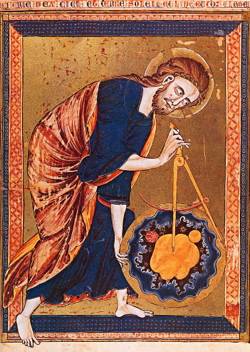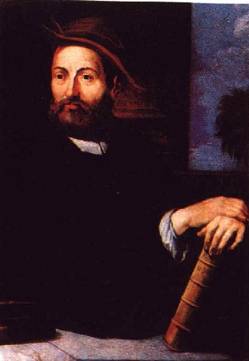On the Origins of New Forms of Life
1.2: The Natural Order
(Continued from the previous page)
 |
|
A medieval depiction of God creating the natural order. |

|
|
Andrea Cesalpino (1519–1603) |
The Natural Order. Early naturalists also thought in terms of Plato's Theory of Ideas. Under this view there were two separate worlds, or "realms of being." There was this world — the one perceived by the senses, the "World of Sensible Things" — and there was a second, imperceptible world, the "World of Ideas."
Medieval churchmen had argued, and the schoolmen of the early scientific era still accepted, that God had created this perfect world of ideas and that it gave order to the perceptible world. The ideas, in their separate realm, were eternal and immutable.¹ In the perceptible world, individuals of a given type differed in nonessential details — each was an imperfect representation, an exemplar, of an essential, eternal, perfect idea. They are seen as mere reflections of an imagined underlying, perfect natural order.
The words used to refer to these ideas or types were those of Aristotelian logic, that is, species and genus. All of the various existing types of organisms were considered eternal and immutable, because it was believed that the various essentiae, which were the supposed principles by which things were made, were themselves eternal.
This notion of a parallel world inhabited by the eternal essences of a divine order will seem far-fetched to most modern readers. But it was generally accepted by early Christian thinkers and by the schoolmen of the medieval and early modern periods. They strove to construct a hierarchy of classification that reflected the existence of a logical natural order demonstrating the existence of a rational divinity. "The best thing in creation," asserted Aquinas (Of God and His Creatures, XLIV), "is the perfection of the universe, which consists in the orderly variety of things."²
In his magnum opus De plantis (1583), Andrea Cesalpino (1519–1603), the first great systematist of the modern era, arranged plants in a hierarchical, graded order. De plantis was written in emulation of Aristotle, from whom Cesalpino borrowed the method of classification by logical division, a method familiar to every educated person from the Middle Ages through the end of the eighteenth century.³
What many biologists fail to realize is that up to about 1800 the activity of classifying organisms remained intricately enmeshed with metaphysics. The writings of classifiers of this era are so suffused with scholastic dogma and jargon that only a specialist can now understand them.⁴ The creator of the modern system of biological nomenclature, the Swedish naturalist, Carl Linnaeus (1707-1788), was no exception. Mayr (1982: 173) says the reason Linnaeus is hard to understand today
"It is principally from Aristotle," observes Daudin (1926),
The same sort of hierarchal system, with categories enclosing categories, is still in use today. However, unlike modern naturalists, the schoolmen thought of these categories as corresponding to the Eternal Ideas, resident in their parallel world beyond the reach of perception. As Lovejoy (1936: 227) points out,
Ironically, the "well-defined species" is a subject with which many biologists are still concerned today. NEXT PAGE >>
1. The very word idea was at that time more narrowly defined than today. Writing in the late eighteenth century, James Boswell comments that Samuel Johnson "was particularly indignant against the almost universal use of the word idea in the sense of notion or opinion, when it is clear that idea can only signify something of which an image can be formed in the mind. We may have an idea or image of a mountain, a tree, a building; but we cannot surely have an idea or image of an argument or proposition" (Life of Johnson, 23 Sept. 1777).
2. Rickaby (1905).
3. Lovejoy (1936: 228); Mayr (1982: 158–159).
4. Mayr (1982: 159).
5. Quoted in Lovejoy (1936: 228).
Most shared on Macroevolution.net:
Human Origins: Are we hybrids?
On the Origins of New Forms of Life
Mammalian Hybrids
Cat-rabbit Hybrids: Fact or fiction?
Famous Biologists
Dog-cow Hybrids
Georges Cuvier: A Biography
Prothero: A Rebuttal
Branches of Biology
Dog-fox Hybrids